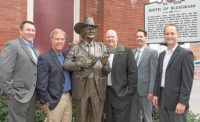One major takeaway from the seventh annual American Supply Association/Supply House Times roundtable discussion that occurred at NETWORK2016 in New York City at the Waldorf-Astoria:
The five blue-chip PHCP-PVF distributors on the panel aren’t afraid to take action to advance the best interests of their respective companies.
The roundtable panel sat down for an hour-plus-long exclusive interview during ASA’s annual convention that morphed into a collaborative and insightful discussion on many industry-relevant topics, including current market conditions, the adaptation of technology, ways to bring new talent into the industry and even candid moments such as navigating family succession among non-family employees. This year’s roundtable panel included:
-
Mike Abeling, President/CEO, Consumers Pipe & Supply, Fontana, Calif.;
-
John Howe, CEO, American Pipe & Supply, Birmingham, Ala.;
-
John Mills, President/CEO, WHCI Plumbing Supply, Union City, Calif.;
-
Jeff New, President, Mid-City Supply, Elkhart, Ind. (Past ASA President); and
-
Randy Wool, President, Wool Plumbing Supply, Miami.
The second installment of this interview appears in the February issue of Supply House Times.
Question: Do you see business heading in the right direction now and in the near future?
The first question out of the gates in New York City quickly turned into a teeter-totter between proactivity and caution. “I think as a group we are getting smarter,” New said. “Forces in the marketplace have required us to become smarter. As we consolidate more in the industry and there are fewer distributors, we all are finding our niche. We can’t be everything to everybody. Mid-City is a lot better off than it was 10 years ago. The old industry is adapting to modern times. We’re not there yet, but we are closer than we used to be. We always have our eye out on the horizon looking for opportunities, but right now we’re making sure we are doing all the right things in the right places.”
Mills added: “This industry now is more willing to listen and learn and adapt to changing business models and other competition to distribution. In that regard, we are in a good spot moving forward. There are some unique areas we are trying to capture, but we don’t want to get too far out of our skis. We’re a small business that likes to take care of its employees. We want to grow smart.
“The economists have said there will be a mild correction in 2018 and then some good years in the 2020s. We look at the five-year horizon in our company to make sure we aren’t doing anything drastic that will prevent us from preparing for the 2020s.”
Wool noted there are 75 cranes in the air in South Florida between Miami and West Palm Beach. “We don’t even have 75 cranes in Indiana,” New responded with a laugh.
However, Wool cautioned the uptick in construction in his neck of the woods doesn’t mesh with what he’s hearing around other parts of country. “There are a handful of hotspots in the country doing very well, but from what I’m hearing, the rest of the country is flat or down a little,” he said. “The economy is delicate. The word is caution. There are a lot of moving parts to our economy and things can shift without much notice. We need to be aware that change can come at any time.”
Howe said American Pipe & Supply is coming off back-to-back double-digit growth years with 2016 ending in record numbers for the Alabama-based distributor.
“We’ve done a good job taking share and being opportunistic and agile,” he said. “We’re taking advantage of our salespeople in our markets. We’ve done a much better job managing salesforce activity. When we see opportunities we will exploit them, but we aren’t going crazy with them.”
Question: Have you been hiring additional staff members and how have you gone about locating this new talent?
Panelists described using common job-search websites such as Indeed and Monster, but then rattled off some other successful, less mainstream ways of finding help.
“We find contractors who want to get out of contracting and have product knowledge,” New said. “Our referrals program has worked well with people who know us and we’ve had success with college interns. You have to hit all fronts.”
Consumers Pipe & Supply has enjoyed success hiring veterans, but also has turned to the junior-college front, but not necessarily in the traditional sense. “There has been a wealth of talent at the local JUCO and not necessarily younger people,” Abeling said. “These are people who may have been laid off and went back to school where they used to be an HVAC tech and want to learn about pumps and have good mechanical ability.”
Mills, whose company is based out of the Bay Area in California, also has tapped into the local college environment. “Several schools in our area have supply-chain management programs,” he said. “So we’re able to find that college graduate looking to get into the distribution industry. We’ve had luck recruiting there.”
American Pipe & Supply looks to the future with its hires. “We try to hire people who can go two jobs above the one we are hiring for,” Howe said. “If we’re hiring someone in the warehouse we’re looking for someone two years from now who can go to inside sales. We’ve had quite a few internal promotions — 20 in the last two years. We are growing and developing our own talent.”
However, another theme during this interaction was the continued difficulty in finding qualified workers. “Because our economy is so strong in South Florida, we haven’t stopped hiring the last five years,” Wool said. “But it’s difficult to get people. People are out there looking for work but they don’t match up for what we need. You could look to the competition, but you have to be careful with that because you could become very vulnerable and they could come right back at you (and poach employees).”
While a familiar refrain in recent years has been that the PHCP-PVF industry is not “sexy,” Wool noted there is a way to take that out of the equation.
“It’s a distribution business,” he said. “We do a lot of things that are compatible with other industries. We need people to drive trucks, fill orders and be part of an office staff. Our industry is unique with the widgets we sell, but it is still distribution. We bring in people who have the skills and can do the tasks of distribution, and we teach them and nurture them and help them learn the products we deal with. As far as trying to get people excited about this industry? We’re at a loss. There’s not much you can do. The nature of the plumbing industry doesn’t attract people.”
The roundtable panelists also presented differing scenarios in terms of employees on the verge of retiring and the process of replacing that veteran experience and expertise.
“We sat down five years ago and made a list of people who won’t be here in 10 years and there are a lot of people, including myself, on the list,” New said. “We are planning for their exits. But on the customer side, it’s the same thing. A lot of our customers are of that age and looking to retire and sell their businesses. We are steering them in the right direction and finding other companies in the area who might be interested. We are trying to manage both sides.”
Consumers Pipe & Supply is trending in the opposite direction. “Our management team mostly is millennials,” Abeling said. “We’ve made a pretty good transition to bring in a good management team and our outside salesforce is younger. We’re in pretty good shape and hopefully in good hands in the future.”
Mills said one obstacle he’s faced is getting veteran workers to feel comfortable enough to open up and share their industry knowledge to younger millennial employees. “That’s something that surprised me,” he said. “Sometimes the veterans are afraid to give up all that knowledge and share customers. We’re working through that as a team.”
On the retirement front, numerous panelists reported having workers older than retirement age on the talent roster and finding ways to accommodate their needs.
“I think it’s more an economic situation. They would rather have that income coming in,” Wool said. “The retirement age traditionally is 65, but that’s a young age today. People still have the energy and desire to work.”
Howe said his company is willing to work with veteran employees who may want to scale back their work commitment, but do not want to completely retire. “We’ve had folks who want to go down to three days and two days a week,” he said. “We’ll work with that because we want that experience around in most cases. The tradeoff is, ‘OK, I’m good with that, but help us develop some new people in these different areas that we will lose experience in knowledge when you retire.’”
New then steered the conversation into candid territory when he discussed the subject of managing family members moving up in the company. New’s two sons, Dan, and Jordan, have worked their way up to key roles in the company. “We had a senior-level person resign because his impressions were that as my sons became more relevant in the company, he became less relevant,” he said. “Shame on me for allowing him to think that. It’s another issue that we have in family business — that perception of the glass ceiling for everybody else. People want to move up, but they see family members in there and say, ‘Why bother? I’m getting out of here.’”
Wool, whose sons, Jeff, and Justin, work in the company, added: “This is a topic that probably is very relevant in most companies.”
Question: How has your company embraced new technology in recent years, particularly when it comes to the internet component?
New again offered a candid assessment of his company’s technological progress. “We are behind on technology, but are making a huge effort to catch up,” he said. “We’ve had Web order entry for 10 years and our customers go there and place orders. That’s 9% of our business overall.”
New’s 9% revelation brought quick response and intrigue from other panelists.
“That’s pretty good. That’s in line with what a Ferguson does,” Howe said. “What type of customers?”
“We’re mostly contractors,” New answered. “It’s all business-to-business, people who have an account with us. It works. Internet competitors are tough and you have to find ways to add value and make yourself more valuable to customers. We can’t compete on price and inventory, they have you beat. You must find other ways.”
Abeling noted Consumers also has online ordering components, but sees numbers closer to 2% of overall business. “We found a lot of times people will go on our site and use our price and call a competitor and use it as a hammer,” he said.
Wool added: “There are a handful of people who want to place orders, but people might also be using online ordering systems to run around town with a price. Mostly, they’re using it for information, if the product’s in stock, spec sheets and how long it would take to get if they ordered.”
Circling back to the proactive theme, Mills explained how an upgrade to WHCI’s computer system has helped the company better work with buyers who deal in mass purchases. “A buyer is at his or her desk doing all their buying on the computer—maybe it’s for showrooms” he said. “From us they want price and availability so they can get a sale. We have one company in the Bay Area here that does 85 to 90% of its business on the internet. One of the challenges we’ve had is buyers have their own computer systems. Even if we offer them something, all they want is info and I’m not sure they’d duplicate efforts for our sake.
“We looked into optical recognition software where it can take a PDF out of the buyer’s system and convert it into an EDI transaction. If you get a large-volume buyer that does a lot of transactions, it could tie up your inside sales guy if they’re doing 25 releases for a project and each house has a release with 30 different items on it. This way, it takes our guy five minutes.”
Mills noted other back-office enhancements at WHCI have included signature capture on orders and integrating order manifests with real-time Google maps. “We can get real-time traffic estimates,” he explained. “If a customer places an order, as soon as the driver leaves with it, the customer will get notification telling them what time the delivery is expected. You have to put in the work on the technology side or you will see degradation of your business in the future.”
Next time, the panel talks about additional hot-button topics such as new threats to the industry, the viability of universal industry product numbers and the value they see in being an ASA member.
This article was originally titled “Taking action” in the January 2017 print edition of Supply House Times.













